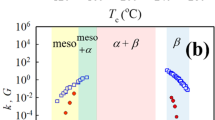Abstract
13C-relaxation times of polystyrene (PS) in its θ solvent, cyclohexane, are measured at different temperatures. A two-step model for the dissolution is proposed. Swelling of the polymer below the θ temperature is eventually the dispersion of the side group phenyl rings only. While above the θ temperature, complete dissolution is the dispersion of the main chain at a molecular level. The results of T1(C) are confirmed by1H-NMR imaging. NMR and its imaging are powerful twls to study the dynamic behavior of dissolution process of polymers in their θ solvents.
Similar content being viewed by others
References
Qian, R., Wu, L., Shen, D.et al., Single-chain polystyrene glasses,Macromolecules, 1993, 26: 2950.
Charlesby, A., Jaroszkiewicz, E. M.:, Entanglement and network formation in polystyrene,Eur. Polym. J., 1985, 21: 55.
Cohen-addad, J. P., Fieo, G., Effects of polymer chain disentanglement on NMR properties,J. Polym. Sci. Polym. Phys. Ed., 1984, 22: 957.
Inoue, Y., Konno, T., A carbon-13 NMR study of molecular motion of polystyrene in solution,Polym. J., 1976, 8: 457.
Cohen-added, J. P., NMR and fractal properties of polymeric liquids and gels, part V. NMR and changes of thermodynamic states,Progress in Nuclear Magnetic Resonance Spectroscopy, 1993, 25: 271.
Slichter, W. P., Davis, D. D., Nuclear magnetic resonance studies of polyisobutylene solutions,Macromolecules, 1968, 1: 47.
Harris, R. K.,Nuclear Magnetic Resonance Spectroscopy, Britain: Longman Group UK Ltd., 1986, 87.
Einaga, Y., Miyaki, Y., Fujita, H., Intrinsic viscosity of polystyrene,J.Polym,Sci. Polym. Phys. Ed., 1979, 17: 2103.
Feng, H., Feng, Z., Yuan, H.etal., A high-resolution solid-state NMR study of the miscibility, morphology, and toughening mechanism of polystyrene with poly(2, 6-dimethyl-1, 4-phenylene oxide) blends,Macromolecules, 1992, 25: 5918.
Author information
Authors and Affiliations
Additional information
Project supported by the National Key Projects for Fundamental Research “Macromolecular condensed state”, the State Science and Technology Commission of China.
Rights and permissions
About this article
Cite this article
Mao, S., Ding, G., Yuan, H. et al. NMR relaxation and micro-imaging study of polystyrene in concentrated cyclohexane solution. Sci. China Ser. A-Math. 40, 408–411 (1997). https://doi.org/10.1007/BF02911441
Received:
Issue Date:
DOI: https://doi.org/10.1007/BF02911441




